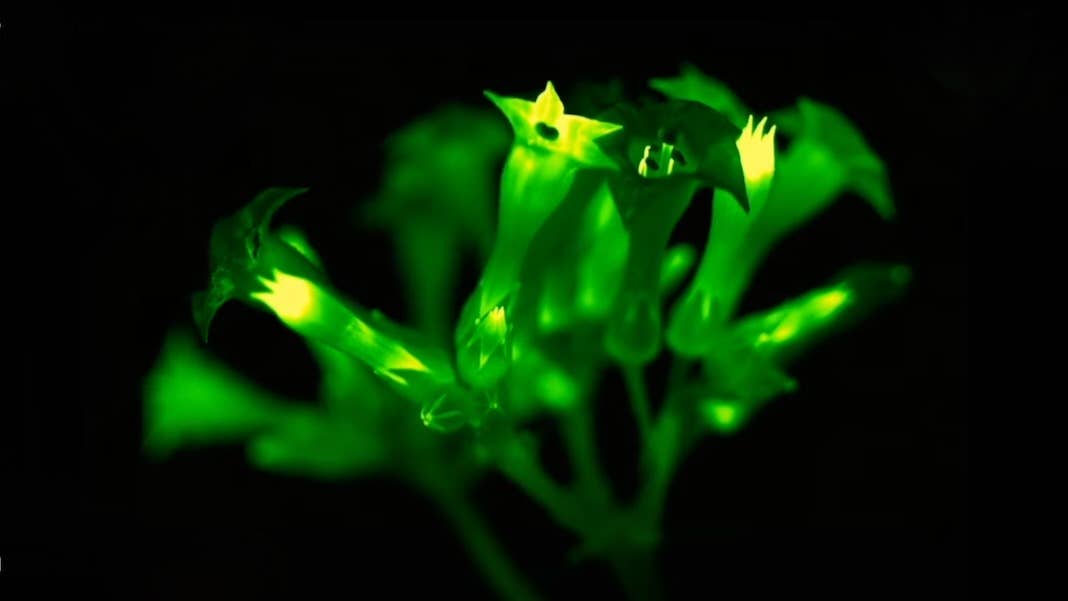You’ll Soon Be Able to Buy Genetically Engineered Glow-in-the-Dark Petunias

Share
Biotechnology is often advertised as the solution to world hunger or a way to cure disease. But new glow-in-the-dark house plants suggest it can have more whimsical uses too.
Our rapidly improving ability to edit the genetic code is opening doors to all kinds of groundbreaking new possibilities. From tackling malnutrition with vitamin fortified rice to re-engineering the body’s immune cells to fight cancer, the technology is being put to use tackling some of the world’s most pressing problems.
But while most efforts to take advantage of advances in biotechnology are decidedly practical, others are driven by more aesthetic goals. Since its founding in 2019, Idaho-based startup Light Bio has been using genetic engineering to splice genes from a bioluminescent mushroom into the humble petunia.
The goal is to create glow-in-the-dark house plants that could help turn people’s homes into a scene from the movie Avatar, according to a report in Wired. And earlier this month, the company finally got permission from the US Department of Agriculture to sell its neon green petunias in the US.
Bioluminescence isn’t a particularly rare trick in nature: certain bacteria, fish, amphibians, insects, and even worms can glow. But getting plants to do it is harder than it might seem. While groups have previously managed to create luminous foliage by inserting genes from fireflies or bacteria into plants, they either didn’t glow very brightly or needed chemical treatments to light up.
The key, it turns out, is adding genetic components that integrate well with the host. Light Bio says they’ve managed to do this by borrowing a metabolic pathway found in mushrooms that produces luciferin—the molecule responsible for bioluminescence. The pathway relies on a molecule known as caffeic acid, which is already found in significant quantities in plants where it is used to build cell walls.
The company’s product is based on research carried out by cofounder Karen Sarkisyan, a professor at Imperial College London. In 2020, his team borrowed DNA from the tropical mushroom Neonothopanus nambi and inserted it into tobacco plants, a popular model organism for plant research. The leaves, stems, roots, and flowers of the engineered foliage glowed bright green.
Now they’ve applied the same idea to petunias, which they plan to start selling next year. The company already has 10,000 people on their waiting list, and they also hope to expand into other popular ornamental species.
Be Part of the Future
Sign up to receive top stories about groundbreaking technologies and visionary thinkers from SingularityHub.


In determining whether the company could sell its plants, the USDA only considered whether the modified petunias were more likely to risk encouraging more plant pests compared to regularly cultivated petunias. But Jennifer Kuzma, codirector of the Genetic Engineering and Society Center at North Carolina State University, told Wired the plants could pose other ecological risks by impacting insects and animals not accustomed to glowing plants.
Given the glow-in-the-dark plants are primarily designed to be decorative, whether those risks are worth taking could be up for debate. But there could also be more practical uses for plants that can emit light. In 2021, researchers at MIT combined genetically engineered bioluminescent plants with energy storing nanoparticles to significantly amp up their brightness. The group claimed the light-emitting plants could one day be used to light building interiors without electricity.
And bioluminescence isn’t the only trick that genetic engineers want to imbue our house plants with. French startup Neoplants has modified the ubiquitous golden pothos to enhance its ability to scrub various pollutants out of the air. The goal is to replace electrically powered air purifiers—though you might need a lot of them.
Whether either of these Franken-plants can become more than a novelty remains to be seen. But they do show that as the biotechnology industry matures gene-splicing could soon be popping up in all kinds of products both functional and fun.
Image Credit: Light Bio
Related Articles

Single Injection Transforms the Immune System Into a Cancer-Killing Machine

Data Centers in Space: Will 2027 Really Be the Year AI Goes to Orbit?

New Gene Drive Stops the Spread of Malaria—Without Killing Any Mosquitoes
What we’re reading

